A Critical Review of the Environmental Impact Assessment (EIA) System
VerifiedAdded on 2020/01/07
|10
|2325
|256
Report
AI Summary
This report provides a comprehensive critical review of the Environmental Impact Assessment (EIA) system. It begins with an introduction to EIA, emphasizing its role in assessing environmental impacts and informing decision-making. The report then details the EIA system, including screening processes to determine the need for an EIA, followed by an in-depth look at the assessment phase, which involves predicting impacts and developing mitigation measures. The evaluation of EIA systems is discussed, focusing on design, practices, and outcomes. The report explores potential improvements to enhance EIA performance, emphasizing the importance of focusing on key issues, improving document quality, and strengthening monitoring and accountability. Finally, the report examines the EIA system of New Zealand, highlighting its integration into the planning process and its contribution to environmental management. The report concludes that EIA is an essential tool for sustainable development, while also acknowledging areas for improvement.
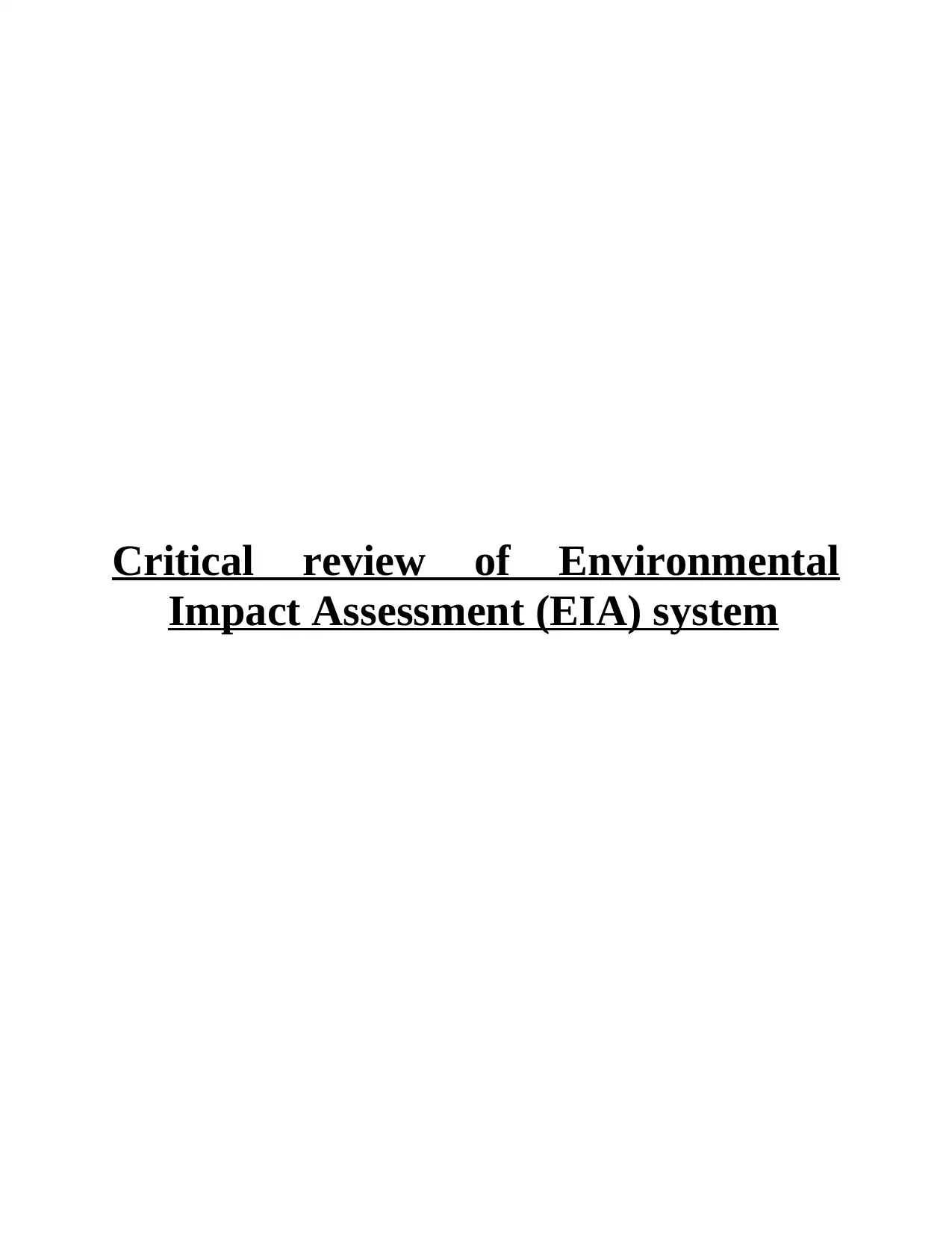
Critical review of Environmental
Impact Assessment (EIA) system
Impact Assessment (EIA) system
Paraphrase This Document
Need a fresh take? Get an instant paraphrase of this document with our AI Paraphraser
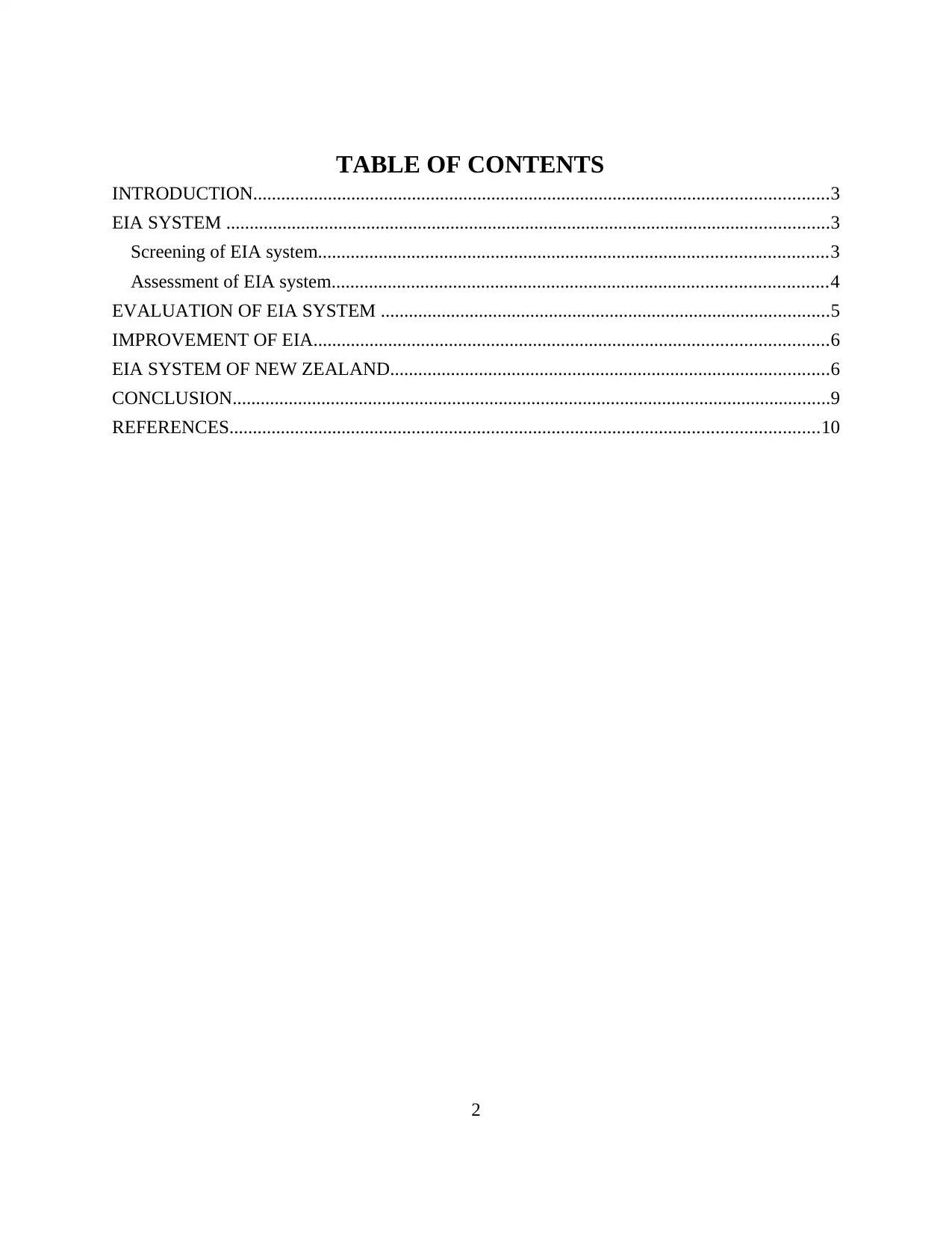
TABLE OF CONTENTS
INTRODUCTION...........................................................................................................................3
EIA SYSTEM .................................................................................................................................3
Screening of EIA system.............................................................................................................3
Assessment of EIA system..........................................................................................................4
EVALUATION OF EIA SYSTEM ................................................................................................5
IMPROVEMENT OF EIA..............................................................................................................6
EIA SYSTEM OF NEW ZEALAND..............................................................................................6
CONCLUSION................................................................................................................................9
REFERENCES..............................................................................................................................10
2
INTRODUCTION...........................................................................................................................3
EIA SYSTEM .................................................................................................................................3
Screening of EIA system.............................................................................................................3
Assessment of EIA system..........................................................................................................4
EVALUATION OF EIA SYSTEM ................................................................................................5
IMPROVEMENT OF EIA..............................................................................................................6
EIA SYSTEM OF NEW ZEALAND..............................................................................................6
CONCLUSION................................................................................................................................9
REFERENCES..............................................................................................................................10
2
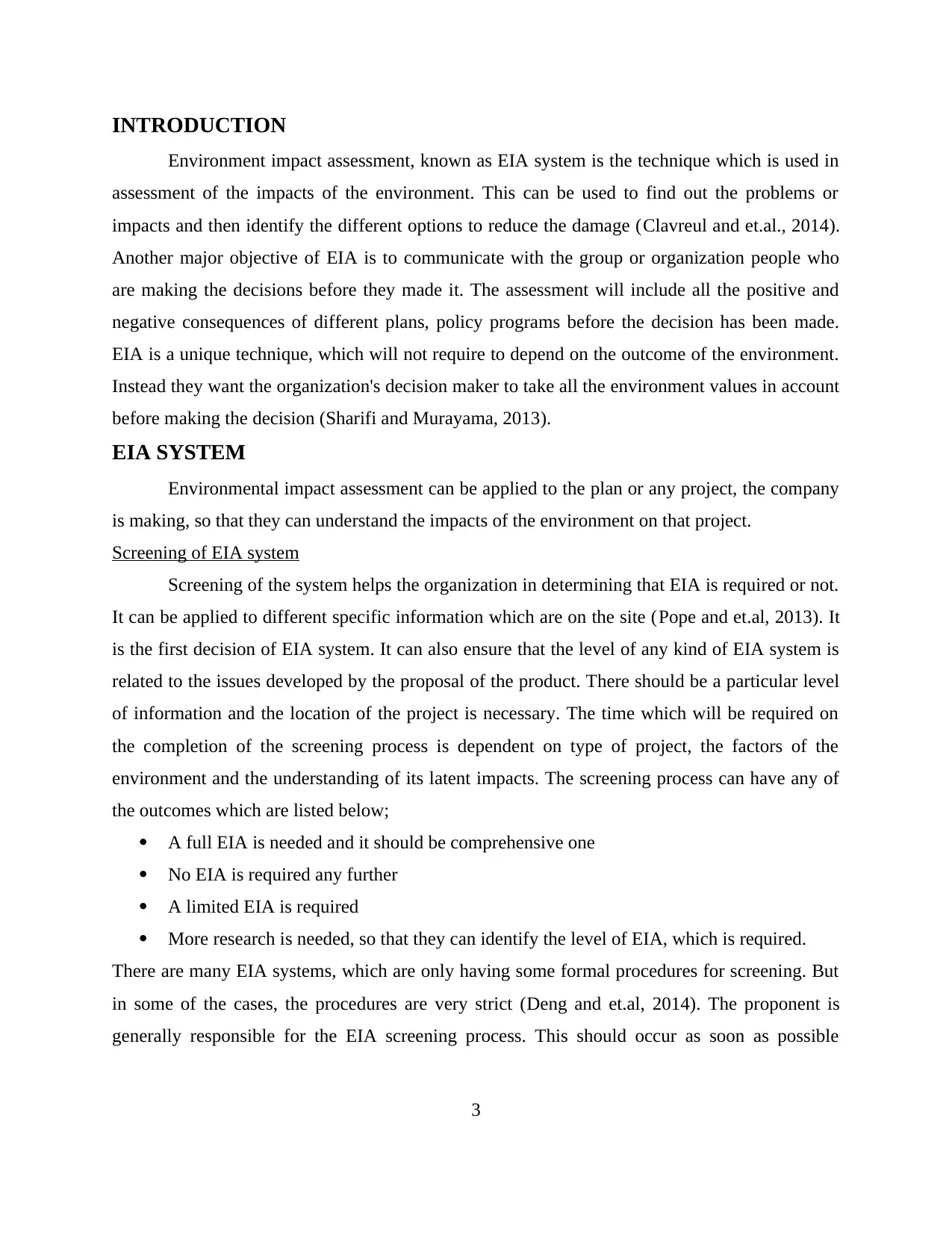
INTRODUCTION
Environment impact assessment, known as EIA system is the technique which is used in
assessment of the impacts of the environment. This can be used to find out the problems or
impacts and then identify the different options to reduce the damage (Clavreul and et.al., 2014).
Another major objective of EIA is to communicate with the group or organization people who
are making the decisions before they made it. The assessment will include all the positive and
negative consequences of different plans, policy programs before the decision has been made.
EIA is a unique technique, which will not require to depend on the outcome of the environment.
Instead they want the organization's decision maker to take all the environment values in account
before making the decision (Sharifi and Murayama, 2013).
EIA SYSTEM
Environmental impact assessment can be applied to the plan or any project, the company
is making, so that they can understand the impacts of the environment on that project.
Screening of EIA system
Screening of the system helps the organization in determining that EIA is required or not.
It can be applied to different specific information which are on the site (Pope and et.al, 2013). It
is the first decision of EIA system. It can also ensure that the level of any kind of EIA system is
related to the issues developed by the proposal of the product. There should be a particular level
of information and the location of the project is necessary. The time which will be required on
the completion of the screening process is dependent on type of project, the factors of the
environment and the understanding of its latent impacts. The screening process can have any of
the outcomes which are listed below;
A full EIA is needed and it should be comprehensive one
No EIA is required any further
A limited EIA is required
More research is needed, so that they can identify the level of EIA, which is required.
There are many EIA systems, which are only having some formal procedures for screening. But
in some of the cases, the procedures are very strict (Deng and et.al, 2014). The proponent is
generally responsible for the EIA screening process. This should occur as soon as possible
3
Environment impact assessment, known as EIA system is the technique which is used in
assessment of the impacts of the environment. This can be used to find out the problems or
impacts and then identify the different options to reduce the damage (Clavreul and et.al., 2014).
Another major objective of EIA is to communicate with the group or organization people who
are making the decisions before they made it. The assessment will include all the positive and
negative consequences of different plans, policy programs before the decision has been made.
EIA is a unique technique, which will not require to depend on the outcome of the environment.
Instead they want the organization's decision maker to take all the environment values in account
before making the decision (Sharifi and Murayama, 2013).
EIA SYSTEM
Environmental impact assessment can be applied to the plan or any project, the company
is making, so that they can understand the impacts of the environment on that project.
Screening of EIA system
Screening of the system helps the organization in determining that EIA is required or not.
It can be applied to different specific information which are on the site (Pope and et.al, 2013). It
is the first decision of EIA system. It can also ensure that the level of any kind of EIA system is
related to the issues developed by the proposal of the product. There should be a particular level
of information and the location of the project is necessary. The time which will be required on
the completion of the screening process is dependent on type of project, the factors of the
environment and the understanding of its latent impacts. The screening process can have any of
the outcomes which are listed below;
A full EIA is needed and it should be comprehensive one
No EIA is required any further
A limited EIA is required
More research is needed, so that they can identify the level of EIA, which is required.
There are many EIA systems, which are only having some formal procedures for screening. But
in some of the cases, the procedures are very strict (Deng and et.al, 2014). The proponent is
generally responsible for the EIA screening process. This should occur as soon as possible
3
⊘ This is a preview!⊘
Do you want full access?
Subscribe today to unlock all pages.

Trusted by 1+ million students worldwide
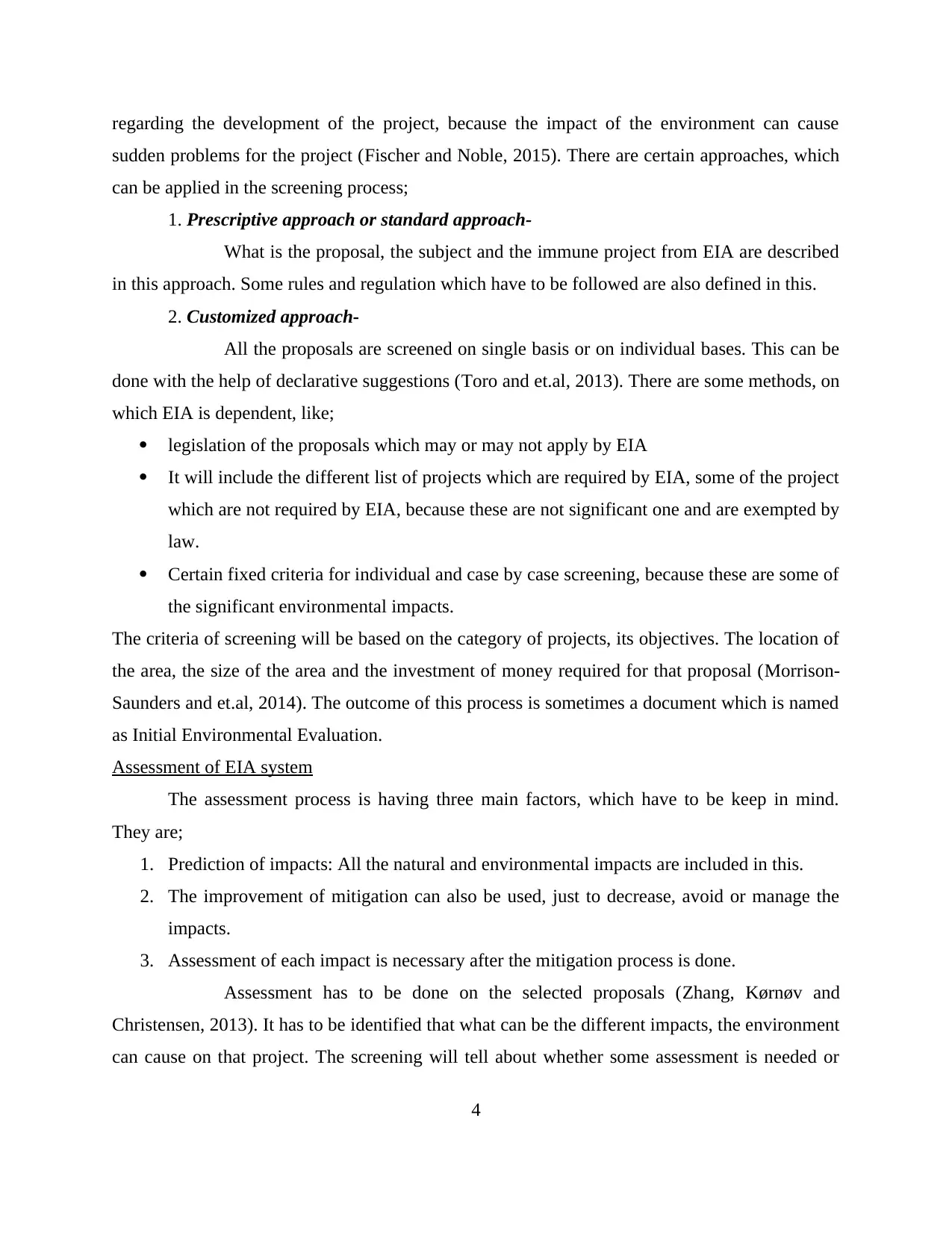
regarding the development of the project, because the impact of the environment can cause
sudden problems for the project (Fischer and Noble, 2015). There are certain approaches, which
can be applied in the screening process;
1. Prescriptive approach or standard approach-
What is the proposal, the subject and the immune project from EIA are described
in this approach. Some rules and regulation which have to be followed are also defined in this.
2. Customized approach-
All the proposals are screened on single basis or on individual bases. This can be
done with the help of declarative suggestions (Toro and et.al, 2013). There are some methods, on
which EIA is dependent, like;
legislation of the proposals which may or may not apply by EIA
It will include the different list of projects which are required by EIA, some of the project
which are not required by EIA, because these are not significant one and are exempted by
law.
Certain fixed criteria for individual and case by case screening, because these are some of
the significant environmental impacts.
The criteria of screening will be based on the category of projects, its objectives. The location of
the area, the size of the area and the investment of money required for that proposal (Morrison-
Saunders and et.al, 2014). The outcome of this process is sometimes a document which is named
as Initial Environmental Evaluation.
Assessment of EIA system
The assessment process is having three main factors, which have to be keep in mind.
They are;
1. Prediction of impacts: All the natural and environmental impacts are included in this.
2. The improvement of mitigation can also be used, just to decrease, avoid or manage the
impacts.
3. Assessment of each impact is necessary after the mitigation process is done.
Assessment has to be done on the selected proposals (Zhang, Kørnøv and
Christensen, 2013). It has to be identified that what can be the different impacts, the environment
can cause on that project. The screening will tell about whether some assessment is needed or
4
sudden problems for the project (Fischer and Noble, 2015). There are certain approaches, which
can be applied in the screening process;
1. Prescriptive approach or standard approach-
What is the proposal, the subject and the immune project from EIA are described
in this approach. Some rules and regulation which have to be followed are also defined in this.
2. Customized approach-
All the proposals are screened on single basis or on individual bases. This can be
done with the help of declarative suggestions (Toro and et.al, 2013). There are some methods, on
which EIA is dependent, like;
legislation of the proposals which may or may not apply by EIA
It will include the different list of projects which are required by EIA, some of the project
which are not required by EIA, because these are not significant one and are exempted by
law.
Certain fixed criteria for individual and case by case screening, because these are some of
the significant environmental impacts.
The criteria of screening will be based on the category of projects, its objectives. The location of
the area, the size of the area and the investment of money required for that proposal (Morrison-
Saunders and et.al, 2014). The outcome of this process is sometimes a document which is named
as Initial Environmental Evaluation.
Assessment of EIA system
The assessment process is having three main factors, which have to be keep in mind.
They are;
1. Prediction of impacts: All the natural and environmental impacts are included in this.
2. The improvement of mitigation can also be used, just to decrease, avoid or manage the
impacts.
3. Assessment of each impact is necessary after the mitigation process is done.
Assessment has to be done on the selected proposals (Zhang, Kørnøv and
Christensen, 2013). It has to be identified that what can be the different impacts, the environment
can cause on that project. The screening will tell about whether some assessment is needed or
4
Paraphrase This Document
Need a fresh take? Get an instant paraphrase of this document with our AI Paraphraser
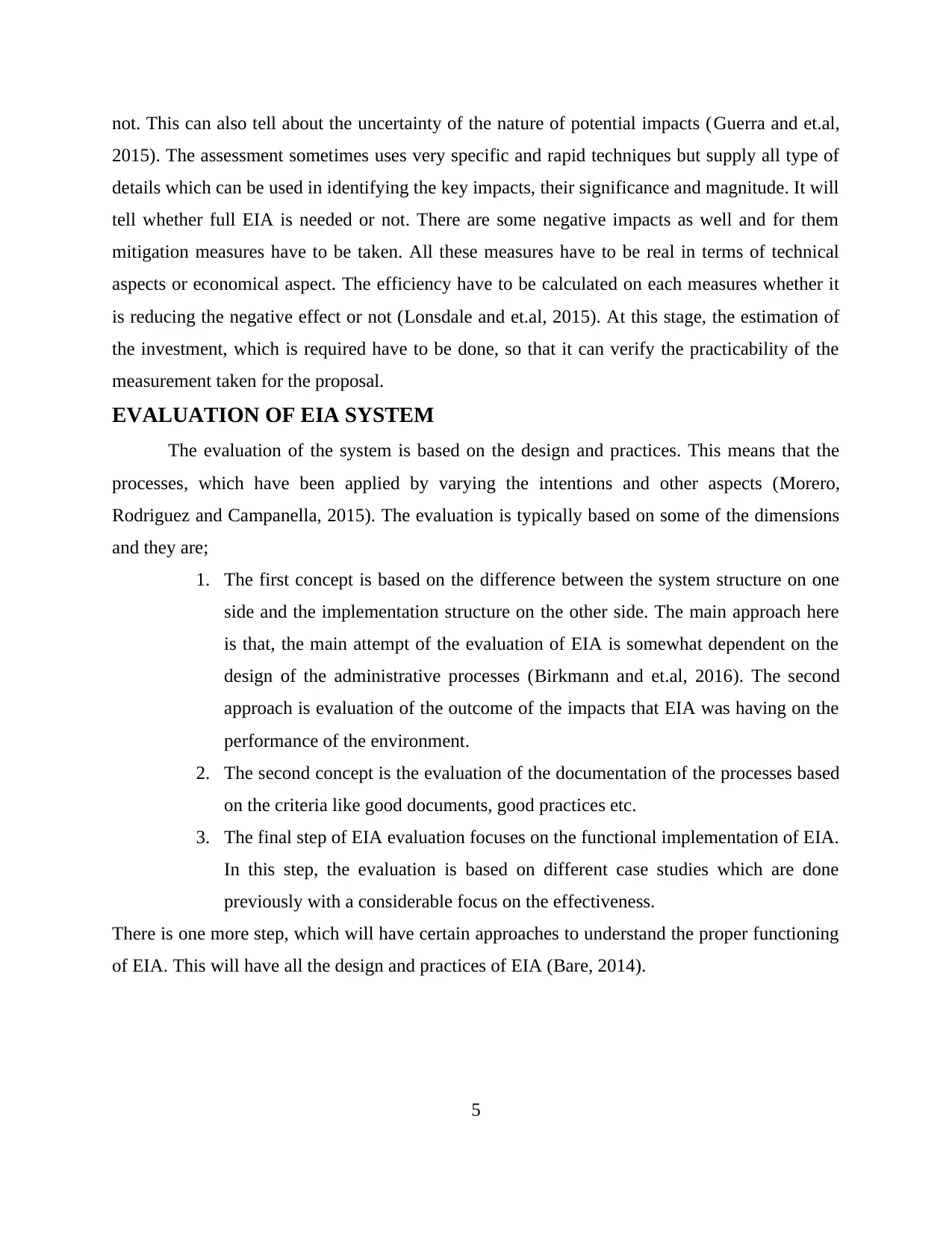
not. This can also tell about the uncertainty of the nature of potential impacts (Guerra and et.al,
2015). The assessment sometimes uses very specific and rapid techniques but supply all type of
details which can be used in identifying the key impacts, their significance and magnitude. It will
tell whether full EIA is needed or not. There are some negative impacts as well and for them
mitigation measures have to be taken. All these measures have to be real in terms of technical
aspects or economical aspect. The efficiency have to be calculated on each measures whether it
is reducing the negative effect or not (Lonsdale and et.al, 2015). At this stage, the estimation of
the investment, which is required have to be done, so that it can verify the practicability of the
measurement taken for the proposal.
EVALUATION OF EIA SYSTEM
The evaluation of the system is based on the design and practices. This means that the
processes, which have been applied by varying the intentions and other aspects (Morero,
Rodriguez and Campanella, 2015). The evaluation is typically based on some of the dimensions
and they are;
1. The first concept is based on the difference between the system structure on one
side and the implementation structure on the other side. The main approach here
is that, the main attempt of the evaluation of EIA is somewhat dependent on the
design of the administrative processes (Birkmann and et.al, 2016). The second
approach is evaluation of the outcome of the impacts that EIA was having on the
performance of the environment.
2. The second concept is the evaluation of the documentation of the processes based
on the criteria like good documents, good practices etc.
3. The final step of EIA evaluation focuses on the functional implementation of EIA.
In this step, the evaluation is based on different case studies which are done
previously with a considerable focus on the effectiveness.
There is one more step, which will have certain approaches to understand the proper functioning
of EIA. This will have all the design and practices of EIA (Bare, 2014).
5
2015). The assessment sometimes uses very specific and rapid techniques but supply all type of
details which can be used in identifying the key impacts, their significance and magnitude. It will
tell whether full EIA is needed or not. There are some negative impacts as well and for them
mitigation measures have to be taken. All these measures have to be real in terms of technical
aspects or economical aspect. The efficiency have to be calculated on each measures whether it
is reducing the negative effect or not (Lonsdale and et.al, 2015). At this stage, the estimation of
the investment, which is required have to be done, so that it can verify the practicability of the
measurement taken for the proposal.
EVALUATION OF EIA SYSTEM
The evaluation of the system is based on the design and practices. This means that the
processes, which have been applied by varying the intentions and other aspects (Morero,
Rodriguez and Campanella, 2015). The evaluation is typically based on some of the dimensions
and they are;
1. The first concept is based on the difference between the system structure on one
side and the implementation structure on the other side. The main approach here
is that, the main attempt of the evaluation of EIA is somewhat dependent on the
design of the administrative processes (Birkmann and et.al, 2016). The second
approach is evaluation of the outcome of the impacts that EIA was having on the
performance of the environment.
2. The second concept is the evaluation of the documentation of the processes based
on the criteria like good documents, good practices etc.
3. The final step of EIA evaluation focuses on the functional implementation of EIA.
In this step, the evaluation is based on different case studies which are done
previously with a considerable focus on the effectiveness.
There is one more step, which will have certain approaches to understand the proper functioning
of EIA. This will have all the design and practices of EIA (Bare, 2014).
5
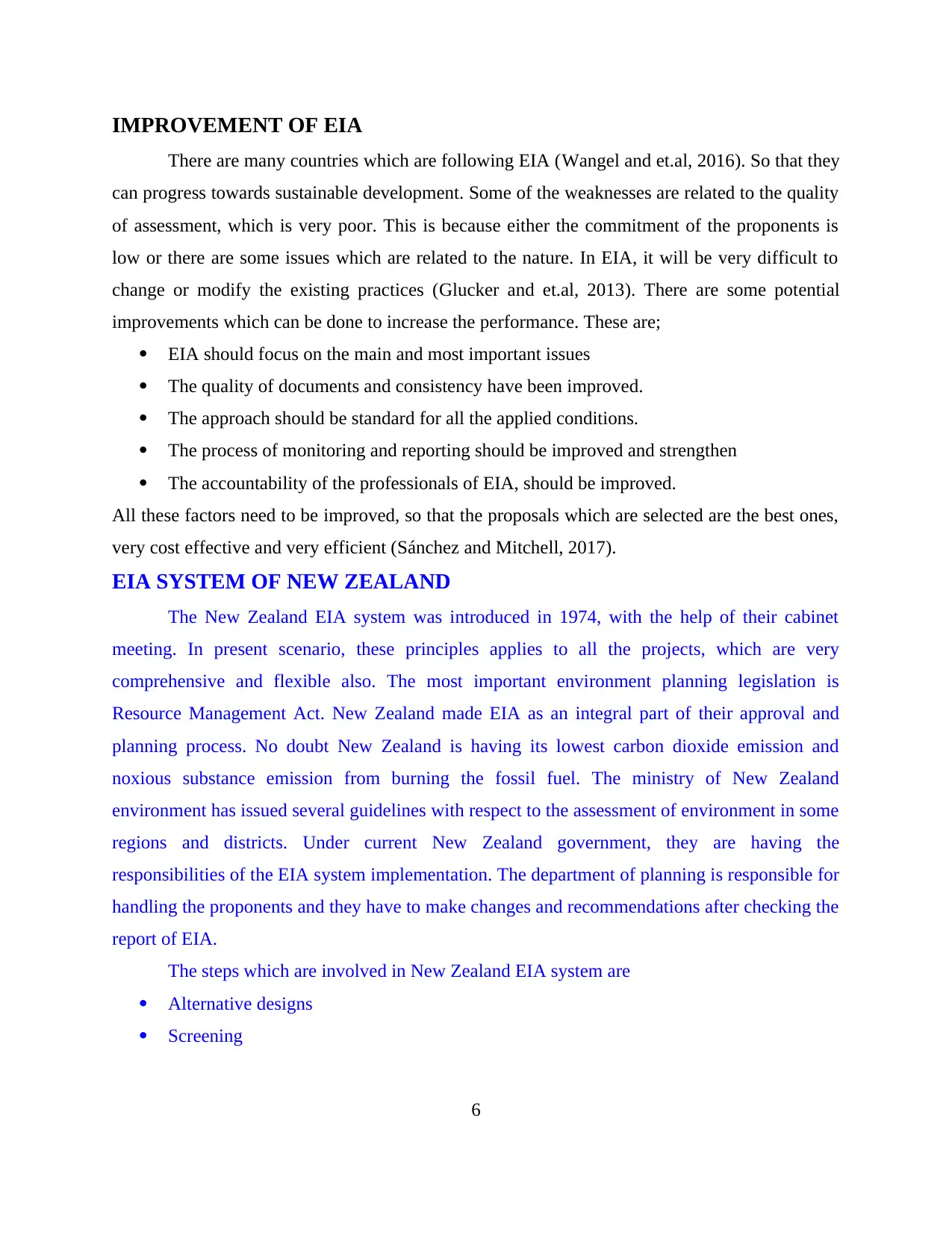
IMPROVEMENT OF EIA
There are many countries which are following EIA (Wangel and et.al, 2016). So that they
can progress towards sustainable development. Some of the weaknesses are related to the quality
of assessment, which is very poor. This is because either the commitment of the proponents is
low or there are some issues which are related to the nature. In EIA, it will be very difficult to
change or modify the existing practices (Glucker and et.al, 2013). There are some potential
improvements which can be done to increase the performance. These are;
EIA should focus on the main and most important issues
The quality of documents and consistency have been improved.
The approach should be standard for all the applied conditions.
The process of monitoring and reporting should be improved and strengthen
The accountability of the professionals of EIA, should be improved.
All these factors need to be improved, so that the proposals which are selected are the best ones,
very cost effective and very efficient (Sánchez and Mitchell, 2017).
EIA SYSTEM OF NEW ZEALAND
The New Zealand EIA system was introduced in 1974, with the help of their cabinet
meeting. In present scenario, these principles applies to all the projects, which are very
comprehensive and flexible also. The most important environment planning legislation is
Resource Management Act. New Zealand made EIA as an integral part of their approval and
planning process. No doubt New Zealand is having its lowest carbon dioxide emission and
noxious substance emission from burning the fossil fuel. The ministry of New Zealand
environment has issued several guidelines with respect to the assessment of environment in some
regions and districts. Under current New Zealand government, they are having the
responsibilities of the EIA system implementation. The department of planning is responsible for
handling the proponents and they have to make changes and recommendations after checking the
report of EIA.
The steps which are involved in New Zealand EIA system are
Alternative designs
Screening
6
There are many countries which are following EIA (Wangel and et.al, 2016). So that they
can progress towards sustainable development. Some of the weaknesses are related to the quality
of assessment, which is very poor. This is because either the commitment of the proponents is
low or there are some issues which are related to the nature. In EIA, it will be very difficult to
change or modify the existing practices (Glucker and et.al, 2013). There are some potential
improvements which can be done to increase the performance. These are;
EIA should focus on the main and most important issues
The quality of documents and consistency have been improved.
The approach should be standard for all the applied conditions.
The process of monitoring and reporting should be improved and strengthen
The accountability of the professionals of EIA, should be improved.
All these factors need to be improved, so that the proposals which are selected are the best ones,
very cost effective and very efficient (Sánchez and Mitchell, 2017).
EIA SYSTEM OF NEW ZEALAND
The New Zealand EIA system was introduced in 1974, with the help of their cabinet
meeting. In present scenario, these principles applies to all the projects, which are very
comprehensive and flexible also. The most important environment planning legislation is
Resource Management Act. New Zealand made EIA as an integral part of their approval and
planning process. No doubt New Zealand is having its lowest carbon dioxide emission and
noxious substance emission from burning the fossil fuel. The ministry of New Zealand
environment has issued several guidelines with respect to the assessment of environment in some
regions and districts. Under current New Zealand government, they are having the
responsibilities of the EIA system implementation. The department of planning is responsible for
handling the proponents and they have to make changes and recommendations after checking the
report of EIA.
The steps which are involved in New Zealand EIA system are
Alternative designs
Screening
6
⊘ This is a preview!⊘
Do you want full access?
Subscribe today to unlock all pages.

Trusted by 1+ million students worldwide
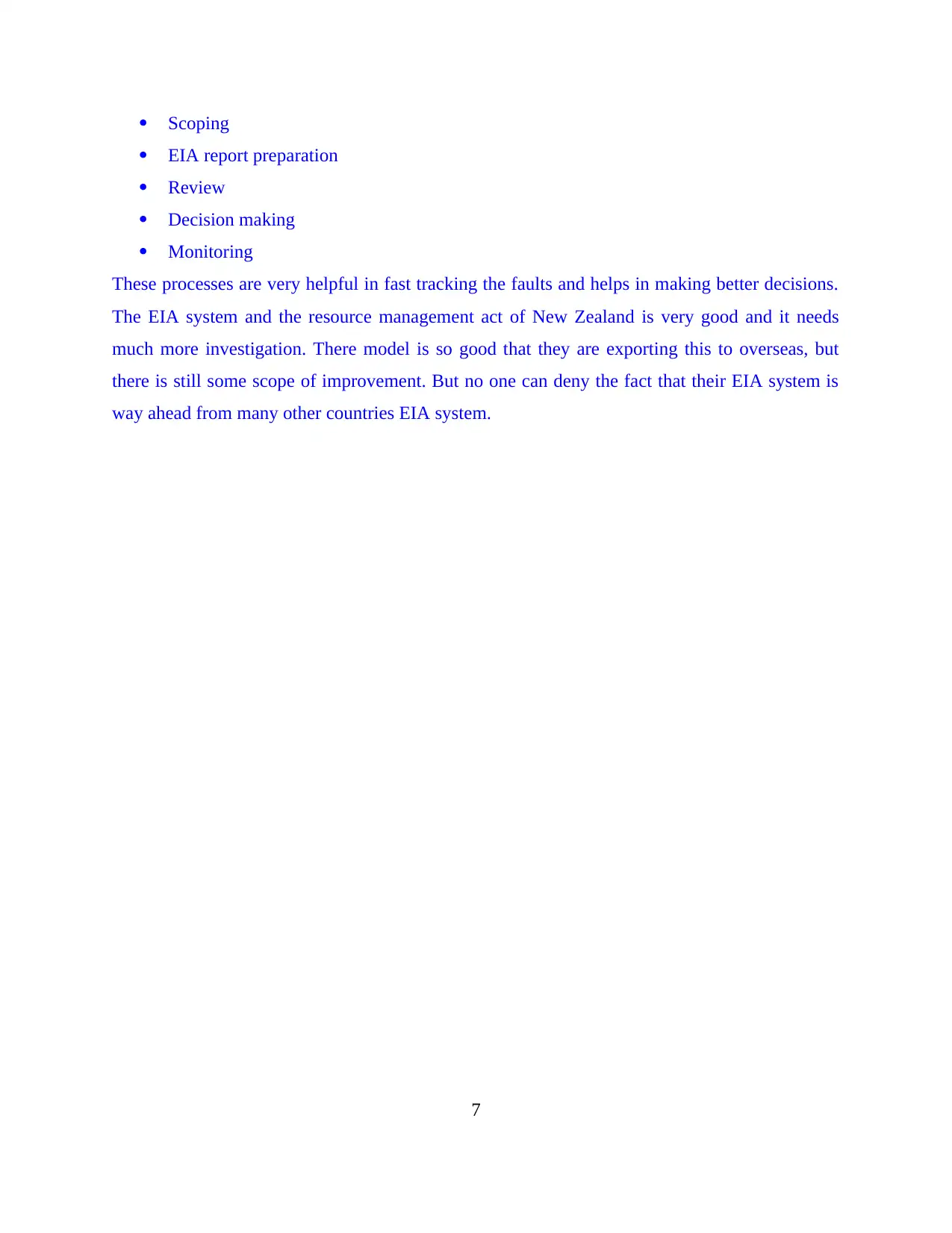
Scoping
EIA report preparation
Review
Decision making
Monitoring
These processes are very helpful in fast tracking the faults and helps in making better decisions.
The EIA system and the resource management act of New Zealand is very good and it needs
much more investigation. There model is so good that they are exporting this to overseas, but
there is still some scope of improvement. But no one can deny the fact that their EIA system is
way ahead from many other countries EIA system.
7
EIA report preparation
Review
Decision making
Monitoring
These processes are very helpful in fast tracking the faults and helps in making better decisions.
The EIA system and the resource management act of New Zealand is very good and it needs
much more investigation. There model is so good that they are exporting this to overseas, but
there is still some scope of improvement. But no one can deny the fact that their EIA system is
way ahead from many other countries EIA system.
7
Paraphrase This Document
Need a fresh take? Get an instant paraphrase of this document with our AI Paraphraser

8
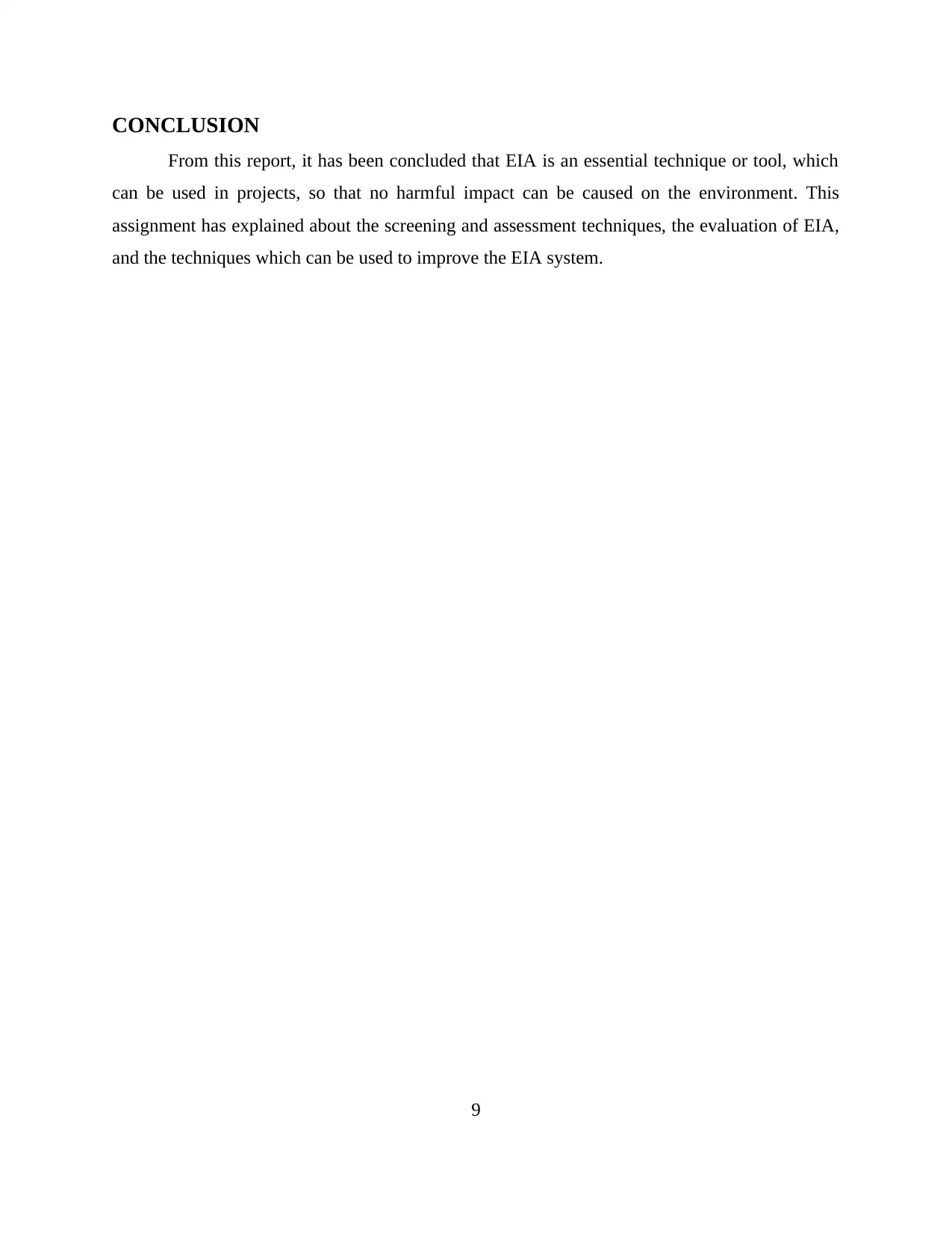
CONCLUSION
From this report, it has been concluded that EIA is an essential technique or tool, which
can be used in projects, so that no harmful impact can be caused on the environment. This
assignment has explained about the screening and assessment techniques, the evaluation of EIA,
and the techniques which can be used to improve the EIA system.
9
From this report, it has been concluded that EIA is an essential technique or tool, which
can be used in projects, so that no harmful impact can be caused on the environment. This
assignment has explained about the screening and assessment techniques, the evaluation of EIA,
and the techniques which can be used to improve the EIA system.
9
⊘ This is a preview!⊘
Do you want full access?
Subscribe today to unlock all pages.

Trusted by 1+ million students worldwide
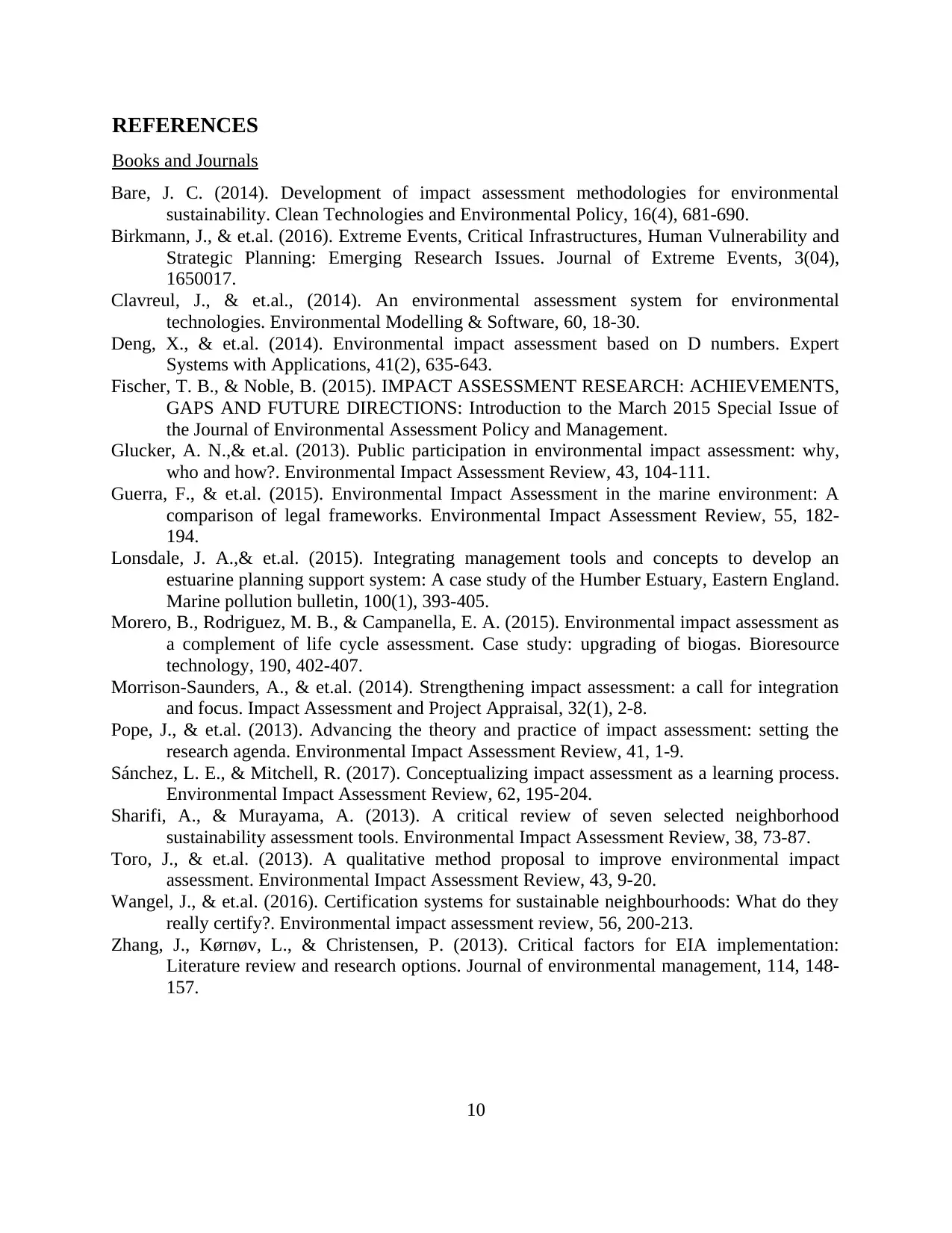
REFERENCES
Books and Journals
Bare, J. C. (2014). Development of impact assessment methodologies for environmental
sustainability. Clean Technologies and Environmental Policy, 16(4), 681-690.
Birkmann, J., & et.al. (2016). Extreme Events, Critical Infrastructures, Human Vulnerability and
Strategic Planning: Emerging Research Issues. Journal of Extreme Events, 3(04),
1650017.
Clavreul, J., & et.al., (2014). An environmental assessment system for environmental
technologies. Environmental Modelling & Software, 60, 18-30.
Deng, X., & et.al. (2014). Environmental impact assessment based on D numbers. Expert
Systems with Applications, 41(2), 635-643.
Fischer, T. B., & Noble, B. (2015). IMPACT ASSESSMENT RESEARCH: ACHIEVEMENTS,
GAPS AND FUTURE DIRECTIONS: Introduction to the March 2015 Special Issue of
the Journal of Environmental Assessment Policy and Management.
Glucker, A. N.,& et.al. (2013). Public participation in environmental impact assessment: why,
who and how?. Environmental Impact Assessment Review, 43, 104-111.
Guerra, F., & et.al. (2015). Environmental Impact Assessment in the marine environment: A
comparison of legal frameworks. Environmental Impact Assessment Review, 55, 182-
194.
Lonsdale, J. A.,& et.al. (2015). Integrating management tools and concepts to develop an
estuarine planning support system: A case study of the Humber Estuary, Eastern England.
Marine pollution bulletin, 100(1), 393-405.
Morero, B., Rodriguez, M. B., & Campanella, E. A. (2015). Environmental impact assessment as
a complement of life cycle assessment. Case study: upgrading of biogas. Bioresource
technology, 190, 402-407.
Morrison-Saunders, A., & et.al. (2014). Strengthening impact assessment: a call for integration
and focus. Impact Assessment and Project Appraisal, 32(1), 2-8.
Pope, J., & et.al. (2013). Advancing the theory and practice of impact assessment: setting the
research agenda. Environmental Impact Assessment Review, 41, 1-9.
Sánchez, L. E., & Mitchell, R. (2017). Conceptualizing impact assessment as a learning process.
Environmental Impact Assessment Review, 62, 195-204.
Sharifi, A., & Murayama, A. (2013). A critical review of seven selected neighborhood
sustainability assessment tools. Environmental Impact Assessment Review, 38, 73-87.
Toro, J., & et.al. (2013). A qualitative method proposal to improve environmental impact
assessment. Environmental Impact Assessment Review, 43, 9-20.
Wangel, J., & et.al. (2016). Certification systems for sustainable neighbourhoods: What do they
really certify?. Environmental impact assessment review, 56, 200-213.
Zhang, J., Kørnøv, L., & Christensen, P. (2013). Critical factors for EIA implementation:
Literature review and research options. Journal of environmental management, 114, 148-
157.
10
Books and Journals
Bare, J. C. (2014). Development of impact assessment methodologies for environmental
sustainability. Clean Technologies and Environmental Policy, 16(4), 681-690.
Birkmann, J., & et.al. (2016). Extreme Events, Critical Infrastructures, Human Vulnerability and
Strategic Planning: Emerging Research Issues. Journal of Extreme Events, 3(04),
1650017.
Clavreul, J., & et.al., (2014). An environmental assessment system for environmental
technologies. Environmental Modelling & Software, 60, 18-30.
Deng, X., & et.al. (2014). Environmental impact assessment based on D numbers. Expert
Systems with Applications, 41(2), 635-643.
Fischer, T. B., & Noble, B. (2015). IMPACT ASSESSMENT RESEARCH: ACHIEVEMENTS,
GAPS AND FUTURE DIRECTIONS: Introduction to the March 2015 Special Issue of
the Journal of Environmental Assessment Policy and Management.
Glucker, A. N.,& et.al. (2013). Public participation in environmental impact assessment: why,
who and how?. Environmental Impact Assessment Review, 43, 104-111.
Guerra, F., & et.al. (2015). Environmental Impact Assessment in the marine environment: A
comparison of legal frameworks. Environmental Impact Assessment Review, 55, 182-
194.
Lonsdale, J. A.,& et.al. (2015). Integrating management tools and concepts to develop an
estuarine planning support system: A case study of the Humber Estuary, Eastern England.
Marine pollution bulletin, 100(1), 393-405.
Morero, B., Rodriguez, M. B., & Campanella, E. A. (2015). Environmental impact assessment as
a complement of life cycle assessment. Case study: upgrading of biogas. Bioresource
technology, 190, 402-407.
Morrison-Saunders, A., & et.al. (2014). Strengthening impact assessment: a call for integration
and focus. Impact Assessment and Project Appraisal, 32(1), 2-8.
Pope, J., & et.al. (2013). Advancing the theory and practice of impact assessment: setting the
research agenda. Environmental Impact Assessment Review, 41, 1-9.
Sánchez, L. E., & Mitchell, R. (2017). Conceptualizing impact assessment as a learning process.
Environmental Impact Assessment Review, 62, 195-204.
Sharifi, A., & Murayama, A. (2013). A critical review of seven selected neighborhood
sustainability assessment tools. Environmental Impact Assessment Review, 38, 73-87.
Toro, J., & et.al. (2013). A qualitative method proposal to improve environmental impact
assessment. Environmental Impact Assessment Review, 43, 9-20.
Wangel, J., & et.al. (2016). Certification systems for sustainable neighbourhoods: What do they
really certify?. Environmental impact assessment review, 56, 200-213.
Zhang, J., Kørnøv, L., & Christensen, P. (2013). Critical factors for EIA implementation:
Literature review and research options. Journal of environmental management, 114, 148-
157.
10
1 out of 10
Related Documents
Your All-in-One AI-Powered Toolkit for Academic Success.
+13062052269
info@desklib.com
Available 24*7 on WhatsApp / Email
![[object Object]](/_next/static/media/star-bottom.7253800d.svg)
Unlock your academic potential
Copyright © 2020–2025 A2Z Services. All Rights Reserved. Developed and managed by ZUCOL.





